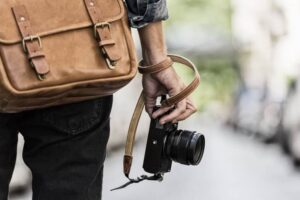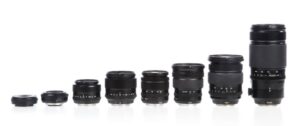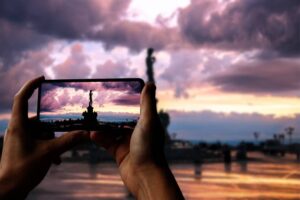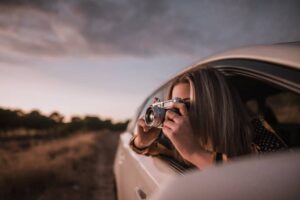I love the element of surprise and taking photos I wasn’t expecting, but as a photographer, I also have to be ready and plan what I want to capture. There is great satisfaction in seeing everything fall into place and creating the photo you have envisioned.
This is the story of one of my favorite fine art photos I took in the Sahara.
A couple of years ago, I traveled to Morocco with a group of photographers and spent a night in a bedouin camp at the edge of the Sahara desert.
Due to the absence of paved roads, there were only two ways to reach the camp: a short bumpy ride in packed SUVs through the dunes, or a more scenic and traditional way: a camel caravan. As photographers, I’ll let you guess which option we picked.
After the 45-minute journey, we reached our camp. We were only going to stay overnight and time was limited. I decided to walk up one of the dunes to scan the area and look for interesting locations to photograph. I’ve always been fascinated by deserts and loved capturing the curves of the dunes and the patterns created by the wind blowing on the fine sand.
Fortunately, right behind our camp was a tall dune that had a perfectly-shaped peak and a soft curve with untouched sand. That was going to be my background for my photos, I just needed to find a subject.
The next morning, right before sunrise, one of the guides mentioned they had to walk the camels around to help them stretch and get ready for the journey back.
I knew I had found my perfect subject.
We asked him to walk back and forth on the eastern side of the camp to allow us to capture silhouettes of the camels as the sun was rising in the background.
I took some amazing photos with starbursts of the sun peeking between the camels. But I still wanted to have that dune as my backdrop. I had to move quickly before the light changed.
I picked my gear and walked to the opposite side of the caravan, facing the dune with the sun on my back. I chose my favorite telephoto lens (70-200mm) to zoom in on the camels. The added advantage of a long lens is that it compresses the scene to make the background appear closer to your foreground subject.
With my camera settings dialed in, I took a few test shots to check my exposure. The colors were very saturated from the golden sunlight and the orange sand. That’s when I decided I’d go for a black and white photo.
When the guide walked into my frame, everything just fell into place the way I wanted it. All I had to do was press the shutter button.
I took multiple shots with different compositions: horizontal, vertical, zoomed in and out. It’s always better to go home with multiple options to choose from.
After the camels had their stretch, we enjoyed our last breakfast in the desert, packed our gear and headed back to town.
The final image turned out exactly as I had hoped. It became one of my popular fine-art prints because of its simplicity, clean minimal composition and black and white conversion that makes the shapes and curves stand out, as opposed to the overly saturated colors of the original scene.
And speaking of processing, check back in next week as I’m going to talk about how I converted this photo from the original RAW file into black and white using nothing but Lightroom.












